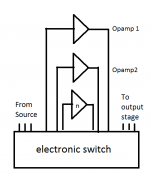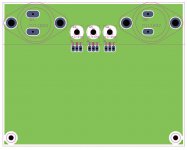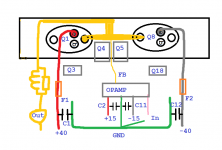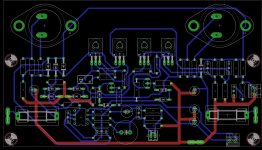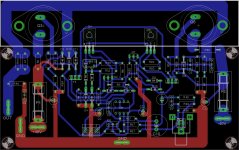Thank you Evette. You could test the amp with them, but the MJ11032/33 has just the right hfe to get the job done in relation to other parameters in the amp. I could also disclose that using the 'formula' I may have build the amp around them 😉
The opamp choice is pretty flexible, meaning one can make a programmable amplifier depending on opamp choice that day.
The opamp choice is pretty flexible, meaning one can make a programmable amplifier depending on opamp choice that day.
Since I have Alot of these output transistors both type I,ll give my friends george and steve ea.8 pairs of your devices and 8 pairs of mind and we,ll then hear which device sounds better. Evette
Any time Evette anytime. I will most likely give them to you for free once they are ready 😉
But my threads have been mashed (rendering them unusable). I do not know Evette . Hope this will be sorted out soon.
. Hope this will be sorted out soon.
But my threads have been mashed (rendering them unusable). I do not know Evette
 . Hope this will be sorted out soon.
. Hope this will be sorted out soon.Hi all,
Looking for volunteers. Kindly lay out this amplifier for me.http://www.harrisonaudiolabs.com/Amplifiers/OPB/OPB.pdf I love your team work. Alex have you laid it out yet 🙂 ? Has anyone seen Drowranger ?
kind regards,
Harrison.
Looking for volunteers. Kindly lay out this amplifier for me.http://www.harrisonaudiolabs.com/Amplifiers/OPB/OPB.pdf I love your team work. Alex have you laid it out yet 🙂 ? Has anyone seen Drowranger ?
kind regards,
Harrison.
OPB uses a clever design. Instead of trying to beat OPamp input with discretes, this amplifier uses opamp with very low distortion.
This is in my book a good idea.
The output uses some voltage amplification to give opamp a target within opamp supply range.
I have done an amplifier like that. Built it too. It sounded just fine. My output was running in pushpull Class A.
This is in my book a good idea.
The output uses some voltage amplification to give opamp a target within opamp supply range.
I have done an amplifier like that. Built it too. It sounded just fine. My output was running in pushpull Class A.
The layout looks great.
It would be great to add the +/- 15 volt zeners and resistors.
I also like the RCA connector for the input, see one on my Avatar.
Only $1.73 from Digikey.
901 Keystone Electronics | 901K-ND | DigiKey
It would be great to add the +/- 15 volt zeners and resistors.
I also like the RCA connector for the input, see one on my Avatar.
Only $1.73 from Digikey.
901 Keystone Electronics | 901K-ND | DigiKey
An externally hosted image should be here but it was not working when we last tested it.
First try, far from complete, but can give an idea 🙂
Thanks for joining us. The first step is all it takes for a great result to come up 😀. To better handle the darling tons temperature control the quick layout has two specific bias control transistors on heat sink. Check the quick layout 😉.
You could bring in the +/-15 onto board or you could extract it from the main supply. The quick layout uses the first option, this really depends on whats at hand. The heavy current tracks need to have their proper width 😉
Had some time for an upgrade
Regards,
Ronny
The layout looks good. It would be great to have some unused pads to the left of the +/- 15 Volt connector to mount zeners, resistors and caps. It looks like enough space if the parts are mounted on end. I use 3-4 pad groups to allow 2-3 component leads and a wire to make a junction.
The top mounting holes look very close to the traces. I don't see the signal pad for the RCA connector.
Here is an example; the DIP package spacing is not needed for this application.
Attachments
- Status
- Not open for further replies.
- Home
- Amplifiers
- Solid State
- HAL OPB amplifier
